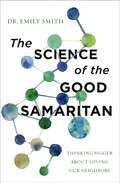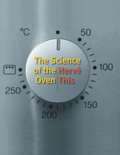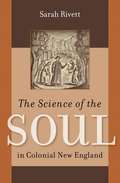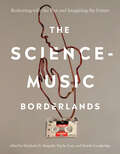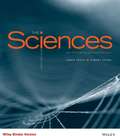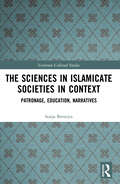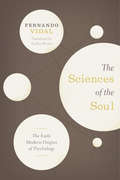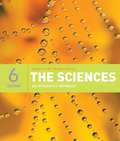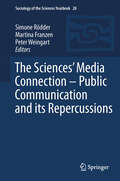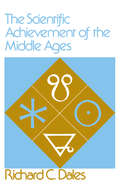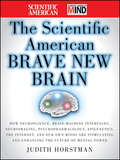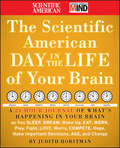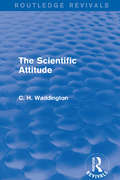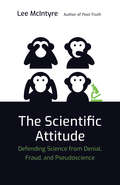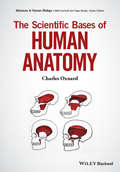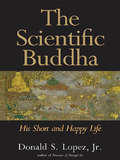- Table View
- List View
The Science of Yoga: The Risks and the Rewards
by William J BroadA lead science writer for The New York Times—and lifelong yoga practitioner—examines centuries of history and research to scrutinize the claims made about yoga for health, fitness, emotional wellbeing, sex, weight loss, healing, and creativity. He reveals what is real and what is illusory, in the process exposing moves that can harm or even kill. A New York Times bestseller.The Science of Yoga draws on more than a century of painstaking research to present the first impartial evaluation of a practice thousands of years old. It celebrates what’s real and shows what’s illusory, describes what’s uplifting and beneficial and what’s flaky and dangerous—and why. Broad unveils a burgeoning global industry that attracts not only curious scientists but true believers and charismatic hustlers. He shatters myths, lays out unexpected benefits, and offers a compelling vision of how the ancient practice can be improved.
The Science of the Good Samaritan: Thinking Bigger about Loving Our Neighbors
by Dr. Emily SmithWhat does it mean to love your neighbor in today's fraught, divided world?Join Dr. Emily Smith, global health expert and creator of the popular Facebook page Friendly Neighbor Epidemiologist, as she dives into what loving your neighbor--as illustrated in the biblical parable of the Good Samaritan--truly means. Combining Dr. Smith's expertise as a scientist with her deep Christian faith while drawing from her journey from small-town Texas to a prestigious university, The Science of the Good Samaritan shares fascinating stories from Dr. Smith's life and the lives of other inspiring people around the world to show us how to:Find shared values with people from different backgrounds, faiths, and cultures than our ownReach outside our immediate circles to bring in those on the marginsRedefine our concept of "neighbor" and love our neighbors in more practical and global waysBridge the gaps of society's disparities and inequitiesYou can help reimagine and create a better world--and it all starts with authentically loving your neighbor.
The Science of the Oven
by Jody Gladding Herv ThisMayonnaise "takes" when a series of liquids form a semisolid consistency. Eggs, a liquid, become solid as they are heated, whereas, under the same conditions, solids melt. When meat is roasted, its surface browns and it acquires taste and texture. What accounts for these extraordinary transformations? The answer: chemistry and physics. With his trademark eloquence and wit, Hervé This launches a wry investigation into the chemical art of cooking. Unraveling the science behind common culinary technique and practice, Hervé This breaks food down to its molecular components and matches them to cooking's chemical reactions. He translates the complex processes of the oven into everyday knowledge for professional chefs and casual cooks, and he demystifies the meaning of taste and the making of flavor. He describes the properties of liquids, salts, sugars, oils, and fats and defines the principles of culinary practice, which endow food with sensual as well as nutritional value. For fans of Hervé This's popular volumes and for those new to his celebrated approach, The Science of the Oven expertly expands the possibilities of the kitchen, fusing the physiology of taste with the molecular structure of bodies and food.
The Science of the Oven (Arts and Traditions of the Table: Perspectives on Culinary History)
by Hervé ThisMayonnaise "takes" when a series of liquids form a semisolid consistency. Eggs, a liquid, become solid as they are heated, whereas, under the same conditions, solids melt. When meat is roasted, its surface browns and it acquires taste and texture. What accounts for these extraordinary transformations?The answer: chemistry and physics. With his trademark eloquence and wit, Hervé This launches a wry investigation into the chemical art of cooking. Unraveling the science behind common culinary technique and practice, Hervé This breaks food down to its molecular components and matches them to cooking's chemical reactions. He translates the complex processes of the oven into everyday knowledge for professional chefs and casual cooks, and he demystifies the meaning of taste and the making of flavor. He describes the properties of liquids, salts, sugars, oils, and fats and defines the principles of culinary practice, which endow food with sensual as well as nutritional value.For fans of Hervé This's popular volumes and for those new to his celebrated approach, The Science of the Oven expertly expands the possibilities of the kitchen, fusing the physiology of taste with the molecular structure of bodies and food.
The Science of the Soul in Colonial New England
by Sarah RivettThe Science of the Soul challenges long-standing notions of Puritan provincialism as antithetical to the Enlightenment. Sarah Rivett demonstrates that, instead, empiricism and natural philosophy combined with Puritanism to transform the scope of religious activity in colonial New England from the 1630s to the Great Awakening of the 1740s.In an unprecedented move, Puritan ministers from Thomas Shepard and John Eliot to Cotton Mather and Jonathan Edwards studied the human soul using the same systematic methods that philosophers applied to the study of nature. In particular, they considered the testimonies of tortured adolescent girls at the center of the Salem witch trials, Native American converts, and dying women as a source of material insight into the divine. Conversions and deathbed speeches were thus scrutinized for evidence of grace in a way that bridged the material and the spiritual, the visible and the invisible, the worldly and the divine.In this way, the "science of the soul" was as much a part of seventeenth- and eighteenth-century natural philosophy as it was part of post-Reformation theology. Rivett's account restores the unity of religion and science in the early modern world and highlights the role and importance of both to transatlantic circuits of knowledge formation.
The Science-Music Borderlands: Reckoning with the Past and Imagining the Future
by Elizabeth Hellmuth Margulis, Psyche Loui, and Deirdre LoughridgeInterdisciplinary essays on music psychology that integrate scientific, humanistic, and artistic ways of knowing in transformative ways.Researchers using scientific methods and approaches to advance our understanding of music and musicality have not yet grappled with some of the perils that humanistic fields concentrating on music have long articulated. In this edited volume, established and emerging researchers—neuroscientists and cognitive scientists, musicians, historical musicologists, and ethnomusicologists—build bridges between humanistic and scientific approaches to music studies, particularly music psychology. Deftly edited by Elizabeth H. Margulis, Psyche Loui, and Deirdre Loughridge, The Science-Music Borderlands embodies how sustained interaction among disciplines can lead to a richer understanding of musical life.The essays in this volume provide the scientific study of music with its first major reckoning, exploring the intellectual history of the field and its central debates, while charting a path forward.The Science-Music Borderlands is essential reading for music scholars from any disciplinary background. It will also interest those working at the intersection of music and science, such as music teachers, performers, composers, and music therapists.Contributors:Manuel Anglada-Tort, Salwa El-Sawan Castelo-Branco, Hu Chuan-Peng, Laura K. Cirelli, Alexander W. Cowan, Jonathan De Souza, Diana Deutsch, Diandra Duengen, Sarah Faber, Steven Feld, Shinya Fujii, Assal Habibi, Erin. E. Hannon, Shantala Hegde, Beatriz Ilari, Jason Jabbour, Nori Jacoby, Haley E. Kragness, Grace Leslie, Casey Lew-Williams, Deirdre Loughridge, Psyche Loui, Diana Mangalagiu, Elizabeth H. Margulis, Randy McIntosh, Rita McNamara, Eduardo Reck Miranda, Daniel Müllensiefen, Rachel Mundy, Florence Ewomazino Nweke, Patricia Opondo, Aniruddh D. Patel, Andrea Ravignani, Carmel Raz, Matthew Sachs, Marianne Sarfati, Patrick E. Savage, Huib Schippers, Jim Sykes, Gary Tomlinson, Jamal Williams, Maria A. G. Witek, Pamela Z
The Sciences (8th Edition): An Integrated Approach
by James Trefil Robert M. Hazen<P>The Sciences: An Integrated Approach, Binder Ready Version, 8th Edition by James Trefil and Robert Hazen uses an approach that recognizes that science forms a seamless web of knowledge about the universe. <P>This text fully integrates physics, chemistry, astronomy, earth sciences, and biology and emphasizes general principles and their application to real-world situations. <P>The goal of the text is to help students achieve scientific literacy.<P> Applauded by students and instructors for its easy-to-read style and detail appropriate for non-science majors, the eighth edition has been updated to bring the most up-to-date coverage to the students in all areas of science.
The Sciences Po Series in International Relations and Political Economy
by Samy CohenNumerous democratic nations have been singled out by NGOs for brutality in their modus operandi, for paying inadequate attention to civilian protection or for torture of prisoners. This book deals with the difficulties faced when conducting asymmetric warfare in populated areas without violating humanitarian law.
The Sciences in Islamicate Societies in Context: Patronage, Education, Narratives (Variorum Collected Studies)
by Sonja BrentjesThis Variorum volume reprints ten papers on contextual elements of the so-called ancient sciences in Islamicate societies between the thirteenth and the seventeenth centuries. They address four major themes: the ancient sciences in educational institutions; courtly patronage of science; the role of the astral and other sciences in the Mamluk sultanate; and narratives about knowledge. The main arguments are directed against the then dominant historiographical claims about the exclusion of the ancient sciences from the madrasa and cognate educational institutes, the suppression of philosophy and other ancient sciences in Damascus after 1229, the limited role of the new experts for timekeeping in the educational and professional exercise of this science, and the marginal impact of astrology under Mamluk rule. It is shown that the muwaqqits (timekeepers) were important teachers at madrasas and Sufi convents, that Mamluk officers sought out astrologers for counselling and that narratives about knowledge reveal important information about scholarly debates and beliefs. Colophons and dedications are used to prove that courtly patronage for the ancient sciences continued uninterrupted until the end of the seventeenth century. Furthermore, these papers refute the idea of a continued and strong conflict between the ancient and modern sciences, showing rather shifting alliances between various of them and their regrouping in the classifications of the entire disciplinary edifice. These papers are suited for graduate teaching in the history of science and the intellectual, cultural and social history of the Middle East and for all readers interested in the study of the contexts of the sciences.
The Sciences of the Artificial (Third Edition)
by Herbert A. SimonContinuing his exploration of the organization of complexity and the science of design, this new edition of Herbert Simon's classic work on artificial intelligence adds a chapter that sorts out the current themes and tools-chaos, adaptive systems, genetic algorithms-for analyzing complexity and complex systems.
The Sciences of the Soul: The Early Modern Origins of Psychology
by Fernando VidalFernando Vidal’s trailblazing text on the origins of psychology traces the development of the discipline from its appearance in the late sixteenth century to its redefinition at the end of the seventeenth and its emergence as an institutionalized field in the eighteenth. Originally published in 2011, The Sciences of the Soul continues to be of wide importance in the history and philosophy of psychology, the history of the human sciences more generally, and in the social and intellectual history of eighteenth-century Europe.
The Sciences: An Integrated Approach (Sixth Edition)
by James Trefil Robert M. HazenOver 100,000 readers have relied on Trefil to gain a better understanding of physics, chemistry, astronomy, earth sciences, and biology. The book focuses on the great ideas in each field while showing readers how core scientific principles connect to their daily lives. The sixth edition emphasizes important themes and relationships, along with new real world connections. Scientific American has been added to the book along with completely updated examples. The presentation also employs a more visual approach that includes new illustrations and visuals. In addition, new problems help readers answer the big questions in science.
The Sciences’ Media Connection –Public Communication and its Repercussions
by Peter Weingart Martina Franzen Simone RödderThe Yearbook addresses the overriding question: what are the effects of the 'opening up' of science to the media? Theoretical considerations and a host of empirical studies covering different configurations provide an in-depth analysis of the sciences' media connection and its repercussions on science itself. They help to form a sound judgement on this recent development.
The Scientific 100
by John Lynda SimmonsWho are the great scientists throughout the ages, and what exactly did they do to earn their importance? From Archimedes to Newton to Einstein to Hawking, The Scientific 100 provides the fascinating answers. Vivid biographical sketches chronicle the lives and accomplishments of the world's preeminent scientists. And in the tradition of the Citadel Press 100 Series, they are ranked provocatively in order of influence--an inspiration for lively discussion. This unique volume is a browser's treasure trove and a handy reference for the general reader. John Simmons has been associated with Current Biography for more than fifteen years. He has written frequently about Nobel laureates in science. A member of the New York Academy of Sciences, he divides his time between New York City and Paris.
The Scientific 100
by Lynda Simmons John SimmonsWho are the great scientists throughout the ages, and what exactly did they do to earn their importance? From Archimedes to Newton to Einstein to Hawking, The Scientific 100 provides the fascinating answers. Vivid biographical sketches chronicle the lives and accomplishments of the world's preeminent scientists. And in the tradition of the Citadel Press 100 Series, they are ranked provocatively in order of influence--an inspiration for lively discussion.This unique volume is a browser's treasure trove and a handy reference for the general reader.John Simmons has been associated with Current Biography for more than fifteen years. He has written frequently about Nobel laureates in science. A member of the New York Academy of Sciences, he divides his time between New York City and Paris.
The Scientific Achievement of the Middle Ages
by Richard C. DalesThe scientists of the twelfth century were daring, original, inventive, and above all determined to discover purely rational explanations of natural phenomena. Their intense interest in the natural world for its own sake, their habits of precise observation, and the high value they place on man as a rational being portend a new age in the history of scientific thought. This book offers a comprehensive sampling of medieval scientific thought in the context of an historical narrative.
The Scientific American Book of Love, Sex and the Brain
by Scientific American Judith HorstmanWho do we love? Who loves us? And why? Is love really a mystery, or can neuroscience offer some answers to these age-old questions?In her third enthralling book about the brain, Judith Horstman takes us on a lively tour of our most important sex and love organ and the whole smorgasbord of our many kinds of love-from the bonding of parent and child to the passion of erotic love, the affectionate love of companionship, the role of animals in our lives, and the love of God.Drawing on the latest neuroscience, she explores why and how we are born to love-how we're hardwired to crave the companionship of others, and how very badly things can go without love. Among the findings: parental love makes our brain bigger, sex and orgasm make it healthier, social isolation makes it miserable-and although the craving for romantic love can be described as an addiction, friendship may actually be the most important loving relationship of your life.Based on recent studies and articles culled from the prestigious Scientific American and Scientific American Mind magazines, The Scientific American Book of Love, Sex, and the Brain offers a fascinating look at how the brain controls our loving relationships, most intimate moments, and our deep and basic need for connection.
The Scientific American Brave New Brain
by Scientific American Judith HorstmanThis fascinating and highly accessible book presents fantastic but totally feasible projections of what your brain may be capable of in the near future. It shows how scientific breakthroughs and amazing research are turning science fiction into science fact. In this brave new book, you'll explore: How partnerships between biological sciences and technology are helping the deaf hear, the blind see, and the paralyzed communicate.How our brains can repair and improve themselves, erase traumatic memoriesHow we can stay mentally alert longer--and how we may be able to halt or even reverse AlzheimersHow we can control technology with brain waves, including prosthetic devices, machinery, computers--and even spaceships or clones.Insights into how science may cure fatal diseases, and improve our intellectual and physical productivityJudith Horstman presents a highly informative and entertaining look at the future of your brain, based on articles from Scientific American and Scientific American Mind magazines, and the work of today's visionary neuroscientists.
The Scientific American Day in the Life of Your Brain
by Horstman Judith NullHave you ever wondered what's happening in your brain as you go through a typical day and night? This fascinating book presents an hour-by-hour round-the-clock journal of your brain's activities. Drawing on the treasure trove of information from Scientific American and Scientific American Mind magazines as well as original material written specifically for this book, Judith Horstman weaves together a compelling description of your brain at work and at play. The Scientific American Day in the Life of Your Brain reveals what's going on in there while you sleep and dream, how your brain makes memories and forms addictions and why we sometimes make bad decisions. The book also offers intriguing information about your emotional brain, and what's happening when you're feeling love, lust, fear and anxiety-and how sex, drugs and rock and roll tickle the same spots. Based on the latest scientific information, the book explores your brain's remarkable ability to change, how your brain can make new neurons even into old age and why multitasking may be bad for you. Your brain is uniquely yours - but research is showing many of its day-to-day cycles are universal. This book gives you a look inside your brain and some insights into why you may feel and act as you do. The Scientific American Day in the Life of Your Brain is written in the entertaining, informative and easy-to-understand style that fans of Scientific American and Scientific American Mind magazine have come to expect.
The Scientific American Day in the Life of Your Brain: A 24 hour Journal of What's Happening in Your Brain as you Sleep, Dream, Wake Up, Eat, Work, Play, Fight, Love, Worry, Compete, Hope, Make Important Decisions, Age and Change (Scientific American)
by Scientific American Judith HorstmanHave you ever wondered what’s happening in your brain as you go through a typical day and night? This fascinating book presents an hour-by-hour round-the-clock journal of your brain’s activities. Drawing on the treasure trove of information from Scientific American and Scientific American Mind magazines as well as original material written specifically for this book, Judith Horstman weaves together a compelling description of your brain at work and at play. The Scientific American Day in the Life of Your Brain reveals what’s going on in there while you sleep and dream, how your brain makes memories and forms addictions and why we sometimes make bad decisions. The book also offers intriguing information about your emotional brain, and what’s happening when you’re feeling love, lust, fear and anxiety—and how sex, drugs and rock and roll tickle the same spots. Based on the latest scientific information, the book explores your brain’s remarkable ability to change, how your brain can make new neurons even into old age and why multitasking may be bad for you. Your brain is uniquely yours – but research is showing many of its day-to-day cycles are universal. This book gives you a look inside your brain and some insights into why you may feel and act as you do. The Scientific American Day in the Life of Your Brain is written in the entertaining, informative and easy-to-understand style that fans of Scientific American and Scientific American Mind magazine have come to expect.
The Scientific Attitude (Routledge Revivals: Selected Works of C. H. Waddington)
by C. H. WaddingtonFirst published in 1941 (this edition in 1968), this book explores the relationship between science, culture, and society- focusing on human beings, and human communities. Here, C. H. Waddington uses the concept of science to mean more than factual information about genes and haemoglobin and his subject is the effect of scientific ways of speaking on the ways in which people look at the world around them. The work discusses biological assumptions made by various communities, particularly fascist movements, on human beings and compares them with the scientific attitude. The Nazis for instance spoke about ‘racial purity’ and ‘German blood’ but these expressions, whilst arousing emotion, had, and have, no rational meaning- they are inaccurate and tell us nothing of human genetics. As well as presenting a scientific argument, being published initially in 1941, this book also acts as a historical document, conveying some of the feeling of living through WWII. It highlights the fact that science and scientific assumptions have very wide implications for the whole conduct of life.
The Scientific Attitude: Defending Science from Denial, Fraud, and Pseudoscience (The\mit Press Ser.)
by Lee McIntyreAn argument that what makes science distinctive is its emphasis on evidence and scientists' willingness to change theories on the basis of new evidence.Attacks on science have become commonplace. Claims that climate change isn't settled science, that evolution is “only a theory,” and that scientists are conspiring to keep the truth about vaccines from the public are staples of some politicians' rhetorical repertoire. Defenders of science often point to its discoveries (penicillin! relativity!) without explaining exactly why scientific claims are superior. In this book, Lee McIntyre argues that what distinguishes science from its rivals is what he calls “the scientific attitude”—caring about evidence and being willing to change theories on the basis of new evidence. The history of science is littered with theories that were scientific but turned out to be wrong; the scientific attitude reveals why even a failed theory can help us to understand what is special about science. McIntyre offers examples that illustrate both scientific success (a reduction in childbed fever in the nineteenth century) and failure (the flawed “discovery” of cold fusion in the twentieth century). He describes the transformation of medicine from a practice based largely on hunches into a science based on evidence; considers scientific fraud; examines the positions of ideology-driven denialists, pseudoscientists, and “skeptics” who reject scientific findings; and argues that social science, no less than natural science, should embrace the scientific attitude. McIntyre argues that the scientific attitude—the grounding of science in evidence—offers a uniquely powerful tool in the defense of science.
The Scientific Bases for Preservation of the Mariana Crow
by Committee on the Scientific Bases for the Preservation of the Mariana CrowThis book, while focusing on current preservation challenges posed by the Aga, or Mariana crow, also reflects the larger issues and challenges of biodiversity conservation in all oceanic island ecosystems. It evaluates causes for the continuing decline of the Aga, which exists on only the two southernmost islands in the Mariana archipelago, Guam and Rota, and reviews actions to halt or reverse the decrease.This book reminds us of the importance and challenge of preserving the unique environmental heritage of islands of the Mariana archipelago, the need for increased knowledge to restore and maintain native species and habitats, and the compelling and lasting value of extensive public education to stimulate environmentally informed public policy development.
The Scientific Bases of Human Anatomy
by Charles Oxnard Kaye B. Brown Matt CartmillAs medical schools struggle to fit ever more material into a fixed amount of time, students need to approach the study of anatomy through a succinct, integrative overview. Rather than setting forth an overwhelming list of facts to be memorized, this book engages readers with a fascinating account of the connections between human anatomy and a wide array of scientific disciplines, weaving in the latest advances in developmental and evolutionary biology, comparative morphology, and biological engineering. Logically organized around a few key concepts, The Scientific Bases of Human Anatomy presents them in clear, memorable prose, concise tabular material, and a host of striking photographs and original diagrams.lustrated with 100 all original photographs and special exploded diagrams highlighting important concepts
The Scientific Buddha: His Short and Happy Life
by Donald S. Lopez Jr.This book tells the story of the Scientific Buddha, "born" in Europe in the 1800s but commonly confused with the Buddha born in India 2,500 years ago. The Scientific Buddha was sent into battle against Christian missionaries, who were proclaiming across Asia that Buddhism was a form of superstition. He proved the missionaries wrong, teaching a dharma that was in harmony with modern science. And his influence continues. Today his teaching of "mindfulness" is heralded as the cure for all manner of maladies, from depression to high blood pressure. In this potent critique, a well-known chronicler of the West's encounter with Buddhism demonstrates how the Scientific Buddha's teachings deviate in crucial ways from those of the far older Buddha of ancient India. Donald Lopez shows that the Western focus on the Scientific Buddha threatens to bleach Buddhism of its vibrancy, complexity, and power, even as the superficial focus on "mindfulness" turns Buddhism into merely the latest self-help movement. The Scientific Buddha has served his purpose, Lopez argues. It is now time for him to pass into nirvana. This is not to say, however, that the teachings of the ancient Buddha must be dismissed as mere cultural artifacts. They continue to present a potent challenge, even to our modern world.

